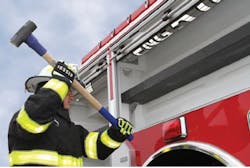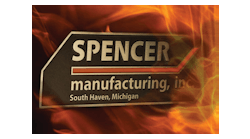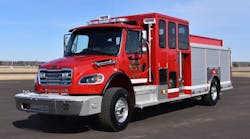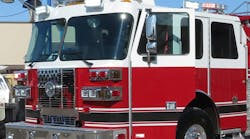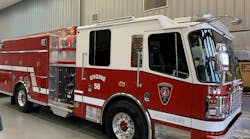Firefighters have a variety of material from which to choose when specifying apparatus bodies. Stainless steel, aluminum, plastics and even some high-tech composite materials are available, and all have advantages.
For decades, fire apparatus was made out of good old-fashioned steel. While there are a few mom-and-pop operations still using steel, most builders use aluminum. Many use stainless and some use polypropylene in the manufacturing of fire apparatus bodies.
Firehouse spoke with apparatus manufacturers and fire truck body builders to learn about material differences.
Sutphen Corporation, a fire truck builder in Dublin, OH, uses aluminum and stainless steel materials in the construction of apparatus.
“We build pumpers using stainless steel or aluminum,” said Zach Rudy, Sutphen’s director of sales and marketing. “Our aerials have aluminum ladders and stainless steel bodies.”
Justin Howell, Sutphen’s sales territory manager, said the company uses 3/16-inch thick aluminum to construct bodies—a much thicker material than some of its competitors.
“It’s stronger and welding is better with minimal warping,” Howell said, noting that welding thin material can weaken it, and warping requires filler to make body surfaces look even remotely smooth.
Bolted Stainless Steel Bodies
When Sutphen uses stainless steel to build a body, it is done in a modular way and panels are bolted together, said Howell. He added that it is challenging to weld stainless steel and requires perfect conditions and meticulous attention to welding speeds and temperatures.
Bolting the panels together avoids welding and also makes it easier to repair when collision damage happens, Howell said.
“You just unbolt [the damaged area] and bolt it back on,” he said. “It gets that $1 million piece of apparatus back in service quicker.”
Stainless is considerably more expensive than aluminum in most cases, Rudy said. The advantage, however, is that stainless is considerably more corrosion resistant than aluminum.
Because of recent tariffs on metals, the cost of raw metals has gone up 40 to 60 percent, Rudy said, noting that other components using metal, like engines, cost more now because of the tariffs as well.
“The cost of a truck has gone up $3,000 to $8,000,” Rudy said. “Cummins engines have gone up. Axles have gone up. Everything has gone up whether it’s our sheet metal, or parts, everything has gone up in price.”
Rudy said Sutphen has “taken the hit internal,” and not passed along the full cost of the tariffs to the customer. “We cut our margins as well,” Rudy said. “It’s not a fun topic to talk about.”
Customers in areas where there’s a lot of salt, brine or other chemicals used for snow removal will often specify stainless steel bodies, Howell said.
The heavier stainless steel body means the apparatus will need heavy axles and heavier suspension to handle the additional weight.
“The [stainless steel] trucks are a little more solid,” Howell said, adding the additional weight affects driving factors—not adversely, but they need to be considered.
“It all depends on what you specify,” he said.
Generally, the fit and finish between stainless steel bodies and aluminum is the same, Rudy said. There are some subtle differences, he added.
Because stainless steel bodies are bolted, there is a little more room in those compartments, compared to aluminum-bodied trucks that use aluminum extrusions which slightly diminish the available space, Howell said.
Carbon Fibre for Reduced Weight
To reduce weight, Sutphen is using carbon fibre material on its cabinet doors.
Some big apparatus doors can be heavy to lift, so Sutphen incorporates the lighter composite material to reduce the weight, Howell said. The new material has been well received in the market place, he added.
Corrosion is a problem for all fire apparatus manufacturers, and Sutphen is always trying to develop new ways to resolve the issue, Howell said.
“We’ve taken great strides to reduce corrosion,” he said, offering examples. When dissimilar metals have to be joined, washers and isolating material, like undercoating, is employed, he said. Even when stainless steel fenderettes over the wheels are attached, an 1/8-inch gap is created with washes to make sure debris doesn’t stick between the two surfaces.
That same attention to detail comes into play when frames are created. Rudy said the company uses a four-step process called Cathacoat, a technique used on bridges where the material is sandblasted, cleaned, primed with a reinforced inorganic, zinc-rich primer and then painted.
Rudy said it's a much better process than a hot-dipped galvanize process that will chip over time.
“We’ve been using it for 12 years and we’ve had zero complaints,” he said.
Galvanneal Steel
When it comes to galvanized material, there was a time when fire trucks were made out of a zinc-coated steel material called galvanneal.
Wyatt Compton, fleet sales application engine for Spartan Emergency Response, based in Charlotte, MI, explained that galvanneal began to fall out of favor in the mid-90s as stainless steel and aluminum became more cost competitive.
“The disadvantage of galvanneal is that the zinc coating must be removed from welded areas to prevent fumes,” Compton said, adding that zinc can cause porous welds. The sheared edges of galvanneal material needed to be coated to prevent corrosion in that unprotected area.
“While it’s a very easy material to have repaired by any facility, stainless, and especially aluminum, gained more favor in the market,” Compton said.
And that’s why Spartan Emergency Response uses both stainless steel and aluminum in construction of its apparatus bodies, Compton said.
Stainless steel has the advantage of having a low reactivity with road chemicals and salt spray, and offers an excellent appearance unpainted over age whether it is unfinished, brushed or polished, Compton said.
The downside of stainless steel, according to Compton, is that it can be difficult to work with, more difficult to cut and drill, and is susceptible to galling.
The advantages of aluminum is it's resistant to corrosion and is easy to work with in that it cuts, drills and forms more easily than stainless steel, Compton said. It’s readily fixed by local body shops, should damage occur, he said.
It’s also lighter, by far, than stainless steel, he added.
One of the biggest disadvantages of aluminum is it can be highly reactive to chemicals that lead to white oxidation and pitting, Compton said, adding that a related problem is galvanic corrosion which occurs when aluminum is in contact with stainless steel or other dissimilar metals.
Compton said corrosion control, from the manufacturing side, is part of the finish process, mostly in the painting of the apparatus. The proper sealing of joints and the joining and fastening of materials is also important in rust prevention, he said.
“After the truck is in service, we would strongly recommend annual cleaning and preventative treatment,” Compton said. "This is especially important in areas using reactive road chemicals. …They are fairly inert once they’re dry, but it’s important to realize that to mitigate damage over time, the chemicals need to be removed thoroughly, and not just re-wetted as part of a cosmetic cleaning.”
Compton said Spartan has experimented with a few alternative materials over the years with mixed results.
“While alternative materials from the trucking or bus industry show promise, they often lack in the combination of formability and material strength over the 20- to 25-year life cycle of fire apparatus,” he said.
Polypropylene Bodies and Tanks
One alternative material that’s already in use is polypropylene from which many of the water tanks in today’s apparatus are constructed, he said, noting that Spartan’s wet-side water tenders have the material exposed and painted.
For ProPoly of America, polypropylene is not an alternative body material but a mainstay of the business for nearly 20 years, said the company’s president and CEO Tim Dean.
The company started building tanks then partnered with W.S. Darley & Co. to form PolyBilt, a business that specializes in truck bodies, particularly for the fire service.
In the past two decades, Dean said the company has built more than 3,000 bodies of all variety and configurations.
“We’ve built complete, full tankers to brush trucks and everything in between,” Dean said.
Poly bodies are popular, Dean said, because there’s little to no maintenance and there’s no issues with corrosion.
“We don’t get a lot of calls at all,” Dean said, speaking of requests for repairs or service. “We usually get good stories about how the bodies ward off damage from collisions, even after some heavy-duty service.”
If a poly body is in a collision, Dean said the impact damage is localized with no energy transfer, Dean said, noting that PolyBilt was recently dispatched to repair collision damage to a tanker in one of the Plains states. The repair was completed in one morning, whereas if the apparatus body had been made of metal, it would have required removal from the chassis and extensive refabricating, Dean said.
Even rollover collisions are no match for polypropylene bodies, in most cases, Dean said. He noted a tanker had rolled over, completely crushing the aluminum cab and doing virtually no damage to the rest of the apparatus.
“The body was in good shape,” Dean said. “The 1,000-gallon tank and the 20-gallon foam cell didn’t even leak."
A 'Very Durable Product'
Polypropylene is also resistant to fire damage, Dean said, noting that some apparatus built by PolyBilt have been caught in wheat field fires. Those apparatus have suffered tire damage, all the vehicle lights, including the warning lights, mirrors, the ABS materials on the cabs and even the paint. The poly bodies, however, have been unscathed, he said.
“It’s a very durable product,” Dean said.
And when it comes to price, Dean said a poly body is about the same price as a stainless steel-bodied apparatus, although it’s much lighter. Also a factor in the price is the volume, he said, noting that PolyBilt is not a high-volume manufacturer. Many of the larger apparatus builders have heavily invested in equipment to manufacture aluminum bodies because it is a good quality, affordable material that works well for fire trucks.
“If saving money is strictly what you’re looking for, then go with aluminum,” Dean said. “Aluminum is a quality product and, usually nestled in the middle of it is a poly tank, hopefully built by us.”
Dean said there are other intrinsic qualities poly has over aluminum and stainless.
“It’s a naturally bright white material that has a beautiful finish,” he said. “When the lights come on inside a compartment, it is so much brighter.”
He said the poly material provides more body configuration flexibility and compartments can be a little deeper and all otherwise wasted space can be used.
“There’s more flexibility in design and it gives builders the opportunity for a little extra customization,” Dean said.
There are a handful of apparatus builders specifying and using poly bodies. In addition to Darley, which is using them extensively in international markets, Midwest Fire, Fouts Brothers, Seagrave, Spencer Manufacturing, Finley Fire and Firematic are all using poly bodies in their fire truck construction.
“There is a good cross section of builders now using them,” Dean said.
When PolyBilt first started making bodies, Dean said there was “a louder chorus of people questioning” the validity of the material for fire trucks, but that has quieted.
“Over the years, we’ve proven it,” Dean said.
Dean said his company has always been “pioneering” something and looking into the future, he said there’s no doubt there will be improvements and new materials from which to build apparatus.
“We are always keeping our eyes peeled,” Dean said, adding that the company has explored with air injection poly which has all the properties of regular poly with the reduction of some weight. The company has also looked at substrate materials and fabrics.
But for now, polypropylene is where it’s at.
“If you were to take a truck and go beyond the standard and go with a performer, you should go with poly,” Dean said.
